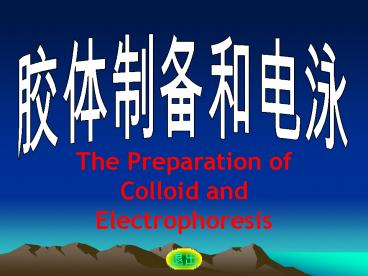The Preparation of Colloid and
1 / 22
Title:
The Preparation of Colloid and
Description:
The Preparation of Colloid and Electrophoresis –
Number of Views:94
Avg rating:3.0/5.0
Title: The Preparation of Colloid and
1
???????
The Preparation of Colloid and Electrophoresis
??
2
Content
- Purposes and Demands
- Principle
- Apparatus and Reagent
- procedure
- Data Records and Processing
- Questions
- Attentions
- Demonstration
3
Purposes and Demands
- Command the principle and technique of
electrophoresis used to determine ? potential. - Determine ? potential of Fe(OH)3 colloid by
electrophoresis method.
4
Principle
- Nearly all the colloid is electriferous. When
colloid is in an electric field, electriferous
particles would move to certain direction and
this phenomena is called electrophoresis.
5
- There are three reasons why colloids are
electriferous. - Firstly, Colloids ionize or adsorb ions. Other
reason is that triboelectricity is generated by
friction between colloids and disperse medium. - Eletric potential difference between colloids
and disperse medium is called ? potential.
6
- Obviously, in a electric field, colloidss
motion speed is related to? potential, which is
also called electrokinetic potential. - Besides, instability of colloidss coagulation
is related to ? potential. So, ? potential is
very important for us to acquire properties of a
colloid.
7
- Given same eletric field and temperature,
there is a relationship between moving rate U of
colloid and ?
Where ? is viscosity of medium, L stands for
distance between two electrodes and e is
dielectric constant of medium.
8
- We shall be concerned with the moving boundary
method to determine electrophoretic rate. If
boundary between colloid and solution take t time
to move distance l, we obtain - Ul/t
9
- and, Eq. ? can be written in the form
- ?(?ll')/(eVt)
- Where l, l, t and V can be determined towards
the experiment, ? can be looked up from appendix
and e can be figured out from the following
formula
T is thermodynamic temperature.
10
Apparatus and Reagent
- Electrophoresis detector
- Direct-current main
- Stopping-watch
- Funnel 1
- Conductivity detector
- FeCl3 (0.1M)
- NaCl
11
Procedure
- 1. Preparation of pure Fe(OH)3 colloid.
- Mete about 65 ml of Fe(OH)3 solution and heat
it nearly to boiling point. After the colloid is
cooled to room temperature, distribute it into
two osmotic bags,
12
- put bags in beaker which is full of distilled
water and make sure that the colloid is immersed
in liquid entirely. Exchange distilled water
three times and a time per 20 minutes.
13
- 2.Determination of the electrophoresis speed U
and potential grads - a.Wash the electrophoresis detector with
chromic acid. Scrawl the stopcock with vaseline. - b.Confect NaCl solution of which conductivity
is equal to Fe(OH)3 colloid.
14
- C. With a funnel transfer colloid to U tube
until the level is above o scale, turn off the
stopcock and then pour out splith left in U tube.
Add NaCl liquor to two arms of U tube until the
level is about 15 cm in height.
15
- Carefully and slowly revolve the stopcock and
make a clear boundary place between the two
liquids. Put two electrodes into two arms of U
tube and make sure that the electrodes height in
liquids are the same.
16
- b. Set direct-current main at 30V-50V. Mark
down the position of boundary. Take records per
10 min. - d. Mete the distance between two electrodes 3-5
times and figure out an average value. (It is not
the horizontal distance)
17
Sketch-maps of Equipments
18
- Data Records and Processing
- Kinds of colloid
- ?0.001002PaS
- Time of eletrophoresis
- Voltage
- Distance between two electrodes
- Moving distance of boundary
- Rate of colloid
- ?
- What charge did the colloid carry?
19
Questions
- 1.What factors does the colloid motion speed
depend on? - 2.Whats the result if the electrophoresis was
not wash cleanly and some electrolyte stay on
tube wall. - 3.Why should conductivity of NaCl liquor be
close to the colloids?
20
Attentions
- 1.Colloid need to be osmosized as possible as
pure. - 2.Conductivity of the assistant liquor is closed
to colloids. - 3.Operate carefully and make sure the boundary
is clear.
21
(No Transcript)
22
(No Transcript)































